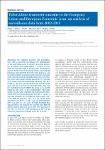Tuberculosis treatment outcome in the European Union and European Economic Area: an analysis of surveillance data from 2002‒2011
Karo, Basel
Hauer, Barbara
Hollo, V.
Werf, Marieke van der
Fiebig, Lena
Haas, Walter
Monitoring the treatment outcome (TO) of tuberculosis (TB) is essential to evaluate the effectiveness of the intervention and to identify potential barriers for TB control. The global target is to reach a treatment success rate (TSR) of at least 85%. We aimed to assess the TB TO in the European Union and European Economic Area (EU/EEA) between 2002 and 2011, and to identify factors associated with unsuccessful treatment. Only 18 countries reported information on TO for the whole observation period accounting for 250,854 new culture-confirmed pulmonary TB cases. The 85% target of TSR was not reached in any year between 2002 and 2011 and was on average 78%. The TSR for multidrug-resistant (MDR)-TB cases at 24-month follow-up was 49%. In the multivariable regression model, unsuccessful treatment was significantly associated with increasing age (odds ratio (OR) = 1.02 per a one-year increase, 95% confidence interval (CI): 1.02–1.02), MDR-TB (OR = 8.7, 95% CI: 5.09–14.97), male sex (OR = 1.40, 95% CI: 1.28–1.52), and foreign origin (OR = 1.32, 95% CI: 1.03–1.70). The data highlight that special efforts are required for patients with MDR-TB and the elderly aged ≥65 years, who have particularly low TSR. To allow for valid monitoring at EU level all countries should aim to report TO for all TB cases.
Dateien zu dieser Publikation
Keine Lizenzangabe

